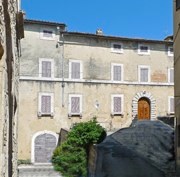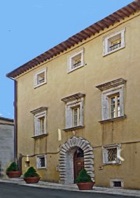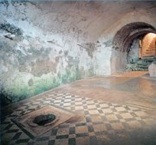

Each of the following has its own page in this website:
Palazzo Boccarini (14th-17th centuries)


This palace that belonged to the Boccarini family, which was documented in Amelia from the late 13th century. The important “Salone Amerino” is in the part of the piano nobile that is in private ownership and entered by a staircase (15th century) in the internal courtyard of the palace. Its frescoes (late 16th century) are attributed to Livio Agresti. They include allegories of Amelia as “Madre Terra” and “Città Forte”.
Palazzo Cansacchi (15th century)

This palace was built against the medieval walls, over-looking Rio Grande. The facade at the rear of the palace incorporated a bifore window and other architectural fragments from an earlier structure. The main portal at the front opens onto an interesting inner courtyard. The palace remained in the ownership of the Cansacchi family until 2001, when it was acquired by Conte Federico Bona Galvagno. He has restored it, as described in the website Palazzo Cansacchi. This site also contains a number of illustrations, including some of the frescoes in the palace.
Palazzo Nacci (14th-16th centuries)



Facade Palazzo Nacci (right), Courtyard
Piazza Marconi from the Loggia dei Banditori Via Carleni
The palace was begun in 1342 by amalgamating three tower houses, but completed only in the late 16th century. The lovely Renaissance portal in Via Carleni opens onto a courtyard and upper loggia.
Palazzo Venturelli (16th century)

The Venturelli family is documented in Amelia from the 14th century. Giovanni Venturelli was active in politics in the 15th century, as Governor of Bologna under Pope Pius II; and then as Governor of the Romagna under Pope Sixtus IV.


The main entrance is at 30 Via Pomponia, but the entrance to the cellars in the street behind is a storey lower. These cellars preserve the remains of what were originally two separate rooms of a Roman domus (ca. 100 BC). Black and white mosaics (2nd century AD) survive on what were the floors of these rooms. (This photograph of the mosaics is in the Museo Archeologico).

The palace is now a hotel: its excellent website has photographs of the Roman mosaics and the piano nobile.
Read more:
This page in the website of the Commune contains more information and a number of images of most of the palaces described above.
Return to Monuments of Amelia.
Return to the Walk around Amelia.

